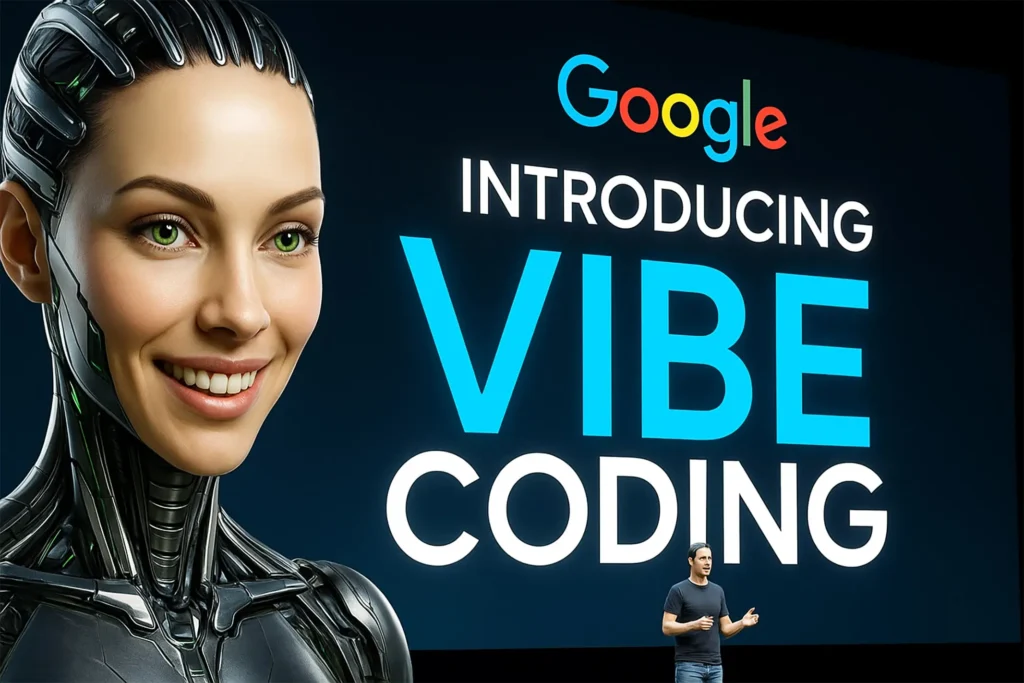Google has once again taken a giant leap in the world of artificial intelligence with the introduction of Vibe Coding — a revolutionary new feature in Google AI Studio that promises to redefine how developers build applications. With Vibe Coding, Google is merging intuitive human creativity with machine intelligence, enabling developers to create apps faster, smarter, and more efficiently than ever before.
This innovation could mark the beginning of a new era where coding is no longer about writing endless lines of code but about expressing ideas through AI-driven interaction.
What Is Vibe Coding?
Vibe Coding is Google’s latest AI-powered development interface designed to transform the traditional app development process. Instead of relying solely on syntax and commands, developers can now communicate their intentions in natural language.
For example, instead of typing complex functions, a developer can simply say, “Create a login page with Google authentication and a dark theme,” and the AI instantly generates production-ready code.
In essence, Vibe Coding is a conversational coding assistant that understands context, learns from your style, and adapts to your project needs in real time.
How Vibe Coding Works
Vibe Coding operates within Google AI Studio, which integrates seamlessly with Gemini, Google’s latest multimodal AI model. Here’s how it works:
- Natural Language Input – Developers describe what they want to build using plain English (or any supported language).
- AI Code Generation – Vibe’s engine translates these descriptions into structured, optimised code across multiple programming languages.
- Real-Time Debugging – The system instantly detects potential errors, offers code fixes, and explains solutions.
- Visual Preview – Users can see real-time visualisations of app components as they’re being created.
- Collaborative Memory – The AI remembers your previous choices, coding patterns, and design preferences for future projects.
Key Features of Vibe Coding
1. Conversational Programming:
No more switching between documentation and code. You can talk to your IDE as if you’re collaborating with another developer.
2. Adaptive Learning:
Vibe Coding learns your style over time — whether you prefer minimalistic UI, modular architecture, or certain libraries.
3. Multi-Platform Support:
It can generate code for Android, iOS, Web, and even cross-platform frameworks like Flutter and React Native.
4. Smart Debugging:
When an error occurs, Vibe doesn’t just fix it — it explains why it happened and provides several alternative solutions.
5. AI-Powered Design Assistance:
It recommends colour palettes, design layouts, and UI/UX improvements using real-time AI analysis.
Why Vibe Coding Is a Game-Changer
Google’s Vibe Coding is not just another AI tool; it’s a paradigm shift in software engineering. By integrating AI directly into the creative process, developers can now focus on innovation and experience, while the AI handles the technical details.
Some of the biggest advantages include:
- Faster Development Time – Apps that once took weeks can now be built in hours.
- Reduced Human Error – The AI ensures your code is efficient, consistent, and bug-free.
- Increased Accessibility – Even beginners with minimal coding experience can now build sophisticated apps.
- Collaborative AI Assistance – Teams can co-create projects with an AI that understands the full development context.
Google AI Studio: The Heart of the Innovation
Vibe Coding is fully integrated into Google AI Studio, Google’s next-generation development environment.
AI Studio now supports a multimodal workflow, meaning developers can use text, voice, or visuals to instruct the AI. It’s designed to be compatible with Google’s Gemini ecosystem, Firebase, Cloud Run, and Vertex AI, giving developers complete control over their build process.
With AI Studio and Vibe Coding combined, Google aims to democratise software creation — empowering anyone, from solo creators to enterprise teams, to develop apps effortlessly.
How It Compares to Other AI Coding Tools
While tools like GitHub Copilot, ChatGPT Code Interpreter, and Replit Ghostwriter have paved the way for AI-assisted coding, Google’s Vibe Coding pushes the concept further by blending emotion-driven interaction, UI generation, and multimodal inputs.
| Feature | GitHub Copilot | ChatGPT Code | Google Vibe Coding |
| Natural Language Coding | ✅ | ✅ | ✅ |
| Visual Code Preview | ❌ | ❌ | ✅ |
| Real-Time Debugging | ⚙️ | ✅ | ✅ |
| Multi-Platform App Building | ❌ | ⚙️ | ✅ |
| Adaptive Learning Memory | ❌ | ⚙️ | ✅ |
Clearly, Vibe Coding isn’t just about assistance — it’s about collaboration, making it feel like coding “with” an intelligent partner rather than “using” a tool.
Conclusion:-
Google AI Studio’s Vibe Coding is not just an upgrade — it’s a revolution. It’s paving the way for a world where coding feels as natural as conversation and as intuitive as creativity itself.
By combining the power of Google’s Gemini AI with real-time collaboration and adaptive intelligence, Vibe Coding could very well define the next era of app development — where technology finally speaks your language.
FAQs:-
1. What is Google Vibe Coding?
Vibe Coding is an AI-powered development feature in Google AI Studio that lets users create apps using natural language and visual inputs instead of traditional code.
2. Is Vibe Coding available for all developers?
Currently, Google is rolling it out in beta through Google AI Studio, with wider access expected soon.
3. Can Vibe Coding build cross-platform apps?
Yes, it supports Android, iOS, and web frameworks, including Flutter and React Native.
4. How does Vibe Coding differ from GitHub Copilot?
Unlike Copilot, Vibe Coding provides real-time visual previews, adaptive learning, and conversational debugging features.
5. Will Vibe Coding replace developers?
No, it’s designed to assist developers, not replace them — enabling faster, smarter, and more creative app development.

